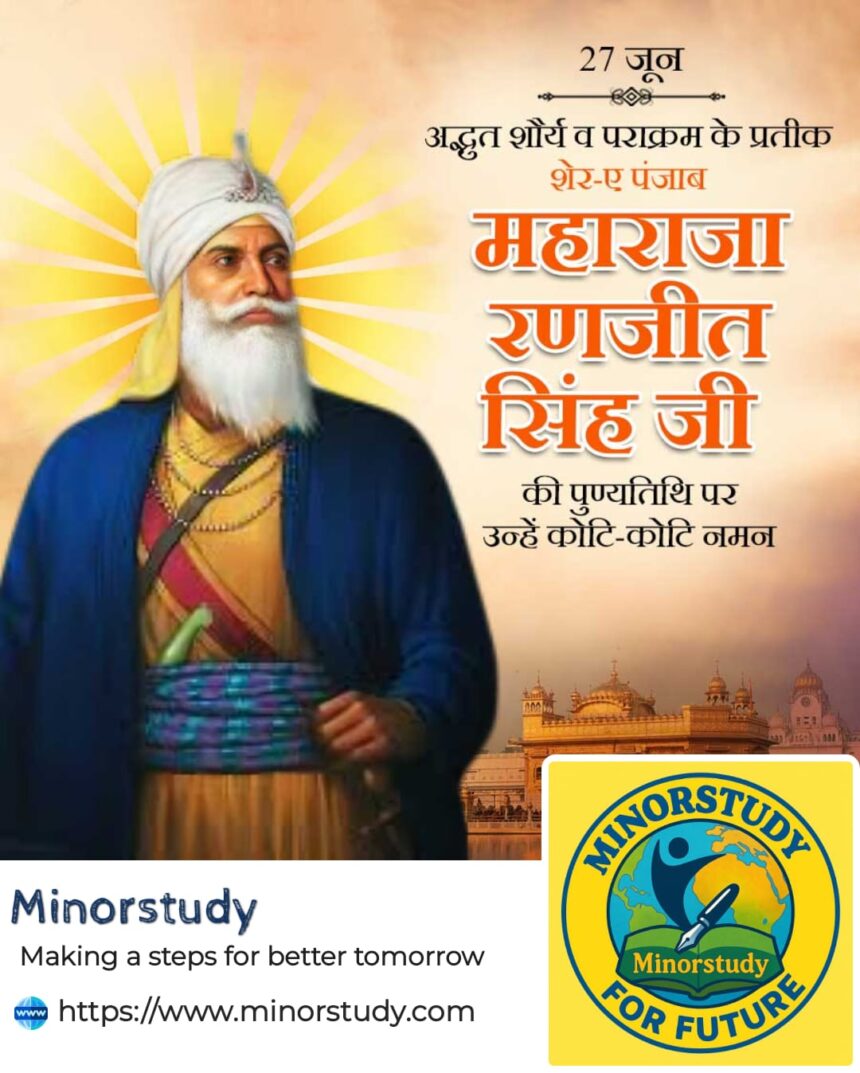👑 Introduction: The Lion of Punjab
Maharaja Ranjit Singh, often called “Sher-e-Punjab” (The Lion of Punjab), was one of India’s most legendary rulers. Born in 1780, he became the founder and leader of the Sikh Empire, uniting a fragmented Punjab into a powerful and secular kingdom.
- 👑 Introduction: The Lion of Punjab
- 🗓️ Timeline of Maharaja Ranjit Singh’s Life
- 📌 Fascinating Facts About Maharaja Ranjit Singh
- 📖 History of Maharaja Ranjit Singh
- 🌟 Significance of Maharaja Ranjit Singh’s Legacy
- 🪔 Observance and Tributes
- 🙏 Heartfelt Wishing on Ranjit Singh Jayanti
- 🛕 Importance in Our Daily Life
- ❓ Frequently Asked Questions (FAQs)
- 1. Was Maharaja Ranjit Singh a king?
- 2. What was Ranjit Singh famous for?
- 3. Did Ranjit Singh ever fight the British?
- 4. Why is Ranjit Singh called “The Lion of Punjab”?
- 5. Did he support only Sikhs?
- 🔖 Important Points at a Glance
- 🌈 Conclusion: Why Maharaja Ranjit Singh’s Life Still Matters Today
He was a visionary leader, a warrior-king, and a champion of religious tolerance, known not just for his battlefield victories but for building an empire rooted in justice, merit, and compassion. His reign stands out as a beacon of peace, prosperity, and inclusive governance.
🗓️ Timeline of Maharaja Ranjit Singh’s Life
| Year | Event |
|---|---|
| 1780 | Born in Gujranwala (now in Pakistan) |
| 1792 | Became chief of the Sukerchakia Misl after his father’s death |
| 1799 | Captured Lahore and established his rule |
| 1801 | Proclaimed himself Maharaja of Punjab |
| 1805-1839 | Expansion of Sikh Empire—Amritsar, Multan, Kashmir, Peshawar, etc. |
| 1839 | Passed away at the age of 59 |
📌 Fascinating Facts About Maharaja Ranjit Singh
Never Lost a Battle: He was undefeated in all the battles he fought.
One-Eyed King: He lost an eye to smallpox in childhood but never let it limit him.
Religious Harmony: Employed Hindus, Muslims, and Christians in his administration and army.
Koh-i-Noor Diamond: Possessed the famous diamond and offered it to Jagannath Temple.
No Capital Punishment: His reign is noted for never sentencing anyone to death.
Military Modernization: Hired French and European officers to modernize his army.
Golden Temple Beautification: Donated gold to cover the Harmandir Sahib (Golden Temple).
Secular Ruler: Restored and maintained temples, mosques, and gurudwaras alike.
Lahore as Capital: Turned Lahore into a flourishing cultural and political hub.
📖 History of Maharaja Ranjit Singh
Ranjit Singh was born into a time of instability. The once-great Mughal Empire was crumbling, and Punjab was divided among multiple warring Sikh clans known as Misls. After his father’s death, Ranjit Singh took charge of the Sukerchakia Misl at the tender age of 12.
By 1799, he had captured Lahore, and in 1801, he declared himself the Maharaja of a unified Punjab. Over the next four decades, he expanded the empire across northern India, including regions of Peshawar, Kashmir, and Multan.
Under his leadership, Punjab became a land of peace, prosperity, and justice—at a time when the rest of India faced colonization and internal decay.
🌟 Significance of Maharaja Ranjit Singh’s Legacy
Unification of Punjab: He was the first and last ruler to unite the entire Punjab region.
Secular Administration: Appointed officials regardless of religion—Hindu prime ministers, Muslim generals, and Christian advisors.
Modern Army: His army rivaled the British in strength and was the most organized indigenous force in India.
Social Reforms: Abolished practices like Sati and ensured women’s safety and property rights.
Justice System: Established a transparent system of justice, favoring reform over punishment.
Cultural Patronage: Promoted music, arts, architecture, and literature.
Symbol of Resistance: His empire remained independent until his death in 1839—unlike most Indian territories that had fallen to the British.
🪔 Observance and Tributes
🗓️ Maharaja Ranjit Singh Jayanti
Date: Celebrated annually, especially in Punjab and by Sikh communities worldwide.
Activities:
Cultural events, seminars, and exhibitions
Processions and tributes at statues and museums
Programs highlighting his secular and strategic governance
🏛️ Memorials and Tributes
Statue in Amritsar: Near the Golden Temple
Statue in Lahore: Installed by the Pakistani government in 2019
Maharaja Ranjit Singh Museum, Amritsar: Former summer palace turned into a museum
UNESCO Honor: Recognized as one of the greatest world leaders in 2020
🙏 Heartfelt Wishing on Ranjit Singh Jayanti
🌼 “On this day, let’s remember the Lion of Punjab, Maharaja Ranjit Singh Ji — a symbol of strength, unity, and secular leadership. May his fearless legacy guide us towards justice, harmony, and compassion.” 🌼
🛕 Importance in Our Daily Life
Maharaja Ranjit Singh’s influence goes far beyond history books:
Inspiration for Ethical Leadership: His example inspires politicians, teachers, and business leaders to lead with integrity.
Model of Secularism: A reminder that diversity is strength, not a weakness.
Military Strategy: Studied by military academies for guerrilla warfare and European-style modernization.
Justice-Oriented Governance: Encourages focus on rehabilitation over punishment.
Cultural Patronage: His legacy continues through festivals, museums, and architectural preservation.
Peaceful Co-existence: Relevant in today’s divisive world for his inclusive policies.
Empowerment: Promoted women’s rights and protection of minorities, making his reign progressive even by today’s standards.
❓ Frequently Asked Questions (FAQs)
1. Was Maharaja Ranjit Singh a king?
Yes, he was the Maharaja (Emperor) of the Sikh Empire from 1801 until 1839.
2. What was Ranjit Singh famous for?
He was famous for uniting Punjab, promoting religious harmony, and building a powerful and modern Sikh Empire.
3. Did Ranjit Singh ever fight the British?
He signed a treaty with the British and avoided direct conflict, maintaining independence until his death. However, after his demise, the British annexed his kingdom in 1849.
4. Why is Ranjit Singh called “The Lion of Punjab”?
Due to his bravery, military leadership, and ability to unite and protect Punjab.
5. Did he support only Sikhs?
No. He had Hindus, Muslims, Christians, and Sikhs in his army and administration.
🔖 Important Points at a Glance
Birth: 1780 | Death: 1839
Empire: Sikh Empire (Punjab, Kashmir, Multan, Peshawar)
Famous for: Unification, justice, secularism, military strength
Nickname: Sher-e-Punjab (Lion of Punjab)
Legacy: Continued inspiration for unity, leadership, and secular values
🌈 Conclusion: Why Maharaja Ranjit Singh’s Life Still Matters Today
In a world of growing divisions and leadership crises, Maharaja Ranjit Singh remains a timeless symbol of justice, tolerance, and courage. His reign stands as a golden chapter in Indian history—a period of peace, prosperity, and unity.
From Lahore to Amritsar, from the battlefield to the court of justice, his life reflects what true leadership means—vision backed by ethics, strength tempered by compassion.
He did not just rule a kingdom; he won hearts. And that is why even today, over 180 years after his death, Maharaja Ranjit Singh continues to live in the spirit of India’s unity and heritage.
#RanjitSingh #SherEPunjab #SikhEmpire #IndianHistory #RanjitSinghJayanti #GoldenTemple #MaharajaRanjitSingh #PunjabiPride #IndianHeroes #UnityInDiversity









WONDERFUL Post.thanks for share..more wait .. …